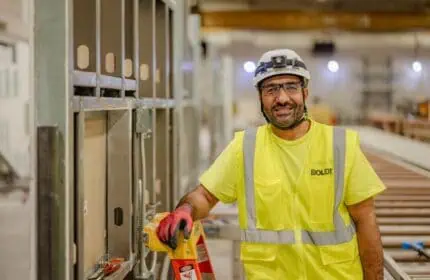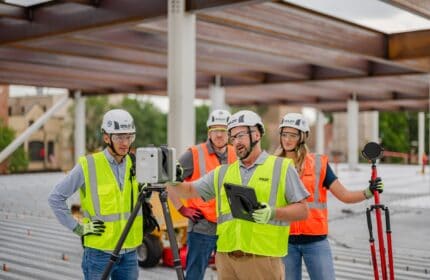Blog
4 Characteristics of High-Performing Lean Teams
What sets high performing teams apart in the Lean construction landscape? It’s the commitment to making sure everyone from owner, designer, contractors, and trade partners are free to contribute and collaborate to achieve a well-defined goal. It’s the ability to adapt to an ever-changing environment. And it’s the transparent management of design and construction where the optimization of the total project is the desired outcome.
As owner, design, and construction partners, Advocate Aurora Health, HGA Architects, and The Boldt Company recently won LCI’s Lean InDesign Award for the Aurora Health Center in Pleasant Prairie, Wisconsin at the 2021 LCI Congress. The team shares their reflections with 4 characteristics of high-performing lean practices on what made the project a success and how it can be applied on your next project.
1. Alignment on Project Goals.
Goals—every construction project needs them, but is everyone on the same page? Are we all aligned to achieve the same goal? Using Target Value Design principles with the entire team of the owner, designer, contractor, and trade partners creates a clear vision of what success looks like. Clarity of the end goal allows the team to identify alternative design solutions, review cost reduction opportunities, identify scope deferments and study productivity improvements. The result is a project scope that achieves the owner’s business case and allowable budget, enabling the project to move forward, minimizing rework. In addition to the current project costs, customers are looking to be set up for success on their next capital project. Creating a master plan not only identifies current design solutions but also provides a roadmap for future design efforts, allowing the customer to grow their business.
2. Culture of Continuous Improvement.
Want to be part of a learning organization and team that supports and commits to continuous improvement? That’s a team that I want to be a part of! Project leadership must nurture a culture that encourages contributions, provides a collaborative learning place and quickly responds to suggestions for improvement. Implement processes or rules of engagement that have clear expectations to facilitate decision making during design and construction. Durable decisions are critical for every successful project. Apply the Lean principle of the Last Planner System and cloud-based planning solutions such as Touchplan to visualize the decision-making process and construction activities to meet project milestones. When something doesn’t go as planned, you have the opportunity to establish a new, improved process that will make your team higher performing.
3. Team Culture Built on Respect and Trust.
When building your team, create one with its own strong identity and vision. Conduct visioning sessions with the owner to help identify the success metrics and goals for their project. All projects typically have cost, schedule, and quality goals, but metrics on team dynamics, project experience, diversity, and community involvement can be additional key drivers to overall satisfaction. High performing teams develop a culture of trust and accountability when they work together, allowing each member to do their best work to achieve extraordinary results.
4. Strong Focus on Generating Value for the Customer.
Every project presents a whole new set of challenges and opportunities. Discover early what your client’s definition of “value” represents. Once target value is aligned, don’t be afraid to get creative on the planning side. The earlier these discussions take place and are reasoned through, the sooner you can confidently get in the ground and start building knowing that the owner’s input and the expertise of trade partners were addressed up front.
High performing teams ask the following questions:
Are we winning or losing?
Create a simple one-page visual dashboard with monthly trending data to score the team on how they are achieving the project goals.
Are we meeting the business case?
Provide clear visuals to communicate the financial health of the project addressing known and unknown risk and opportunities.
Is there a problem here?
Obtain feedback from the project team by conducting third-party pulse surveys at regular intervals throughout the project.
Do I know you?
Have fun! Life is too short. Create the opportunities for teammates to develop relationships and get to know each other outside of formal “big room” and OAC meetings. Host a lunch, grab dinner, have drinks, play your favorite game. Whatever it is, be intentional and make it happen! Relationship currency is critical to develop. You never know when you may need it.
High Performing Teams = Great People + Great Process. Let Lean construction become the catalyst to creating a culture built around innovation and efficiency and instill in the team a feeling of empowerment that says, “I want to repeat this experience.”
Gratitude and thanks for the contributions from Karen McKenzie and Brian Esswein with Advocate Aurora Health, Mark Bultman and Cory Powers with HGA Architects, and Chris Waldron with The Boldt Company.
About The Boldt Company
The Boldt Company (Boldt) is a leading professional construction services firm with customers across the United States and is a subsidiary of The Boldt Group. Founded in 1889, Boldt is a fourth-generation family and employee-owned firm headquartered in Appleton, Wisconsin. Boldt is recognized as a pioneer in Lean construction and in the industrialized construction space. Boldt operates 18 offices across the U.S. that serve customers in healthcare, power, industrial, education, automotive and commercial markets.


